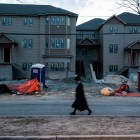
The Potential Perils of the Youth PROMISE Act
|
Could the Youth PROMISE Act result in the over-policing of black and Latino communities?
Juvenile Justice Information Exchange (https://jjie.org/prominence/footer-featured/page/3/)
If you are using the Footer Featured Posts widget, add this label to posts to determine which to display in the widget

Could the Youth PROMISE Act result in the over-policing of black and Latino communities?

This year, President Barack Obama's budget reflects more of the juvenile justice field's priorities than ever before. These funding proposals will be crucial in advancing juvenile justice reforms in a number of ways. The Juvenile Justice and Delinquency Prevention Act (JJDPA) has provided critical federal funding for nearly 40 years, under the Title II formula grant funds, to states to comply with a set of minimum requirements designed to protect children and meet their unique needs. The president’s budget includes $70 million under Title II for states to utilize in keeping status offenders from being detained, removing children from adult jails and lock ups, and reducing the disparate treatment of youth of color in the juvenile justice system. The “deinstitutionalization of status offenders” or “DSO provision,” applies to young people whose actions would not be considered offenses at the age of majority, such as skipping school, running away, breaking curfew and possession or use of alcohol.

In Ramapo, New York, a town divided by race, religion, and culture, a demographic split has allowed public money to pour into private religious schools, resulting in huge cuts to the already decimated public school system. Community leaders fear that the cuts, which will essentially eliminate all non state-mandated programs like music, sports and art, will create a school-to-prison pipeline.

A century after Cook County, Illinois launched the world’s very first separate court system for juveniles accused of delinquency, a study found more than half of the young people in the county's juvenile lock-up suffered from at least one mental health disorder.
Photo courtesy of Rutherford County Government
The Office of Juvenile Justice and Delinquency Prevention(OJJDP) recently released a new report, titled Survey of Youth in Residential Placement (SYRP) 2003. The report, released via the National Archive of Criminal Justice Data, contains information culled from a national survey conducted a decade ago, involving more than 7,000 young people in almost 300 facilities. The report details, among other areas, survey findings about young people and their family backgrounds, their facility experiences and the quality of medical services they received while in placement. About three-quarters of survey respondents were young males, with Caucasian, African-American and Hispanic subjects making up fairly equivalent proportions of the total population surveyed. Regarding upbringing, about 80 percent of respondents said they grew up with a mother as their primary caretaker, with about half the number of respondents stating that they grew up with a father in the same role.

The proposed state budget released by Gov. Martin O’Malley last week indicates that Maryland will not be funding the construction of a controversial youth detention facility in Baltimore. The Baltimore Sun reports that O’Malley’s 2014 FY capital spending plan does not include funding for a proposed 120-bed, $70 million youth jail in Baltimore City. Originally announced in 2008 by Gov. O’Malley, construction plans for the Baltimore City New Youth Detention Facility -- at one point, expected to house 180 inmates at a construction cost of $100 million -- has been in limbo for the last five years, with the Maryland House Appropriations Committee declaring the project suspended in April 2012. Even so, the Baltimore Sun reports that the state has already allocated $14 million for the planning and design of the youth detention facility and an additional $17 million for first phase construction costs. The planned facility has been met with criticism and protests from several groups and organizations, with a white paper released by the National Council on Crime and Delinquency arguing that such a large project was unneeded, considering the city’s decreasing crime rates.

In the aftermath of the deadly shooting last month at Sandy Hook Elementary School in Newtown, Conn., intense public debate has focused on protecting students – and the role of student resource officers (SROs), in particular – in the event of future shooting sprees. Generally, school resource officers are local law enforcement officers appointed to patrol schools and handle juvenile disciplinary issues. The effectiveness of SROs is highly debated. A National Association of School Resource Officers (NASRO) report claims the presence of SROs has reduced juvenile arrests in some schools by nearly 50 percent. On the other hand, the Justice Policy Institute issued a report that found SROs had little effect on curbing criminal activity in schools, and may even lead to inflated, and potentially unnecessary, juvenile arrests.

A new report from the Texas Criminal Justice Coalition finds that statewide drug possession arrests have increased by more than 30 percent from 1999 to 2011, with nine-out-of-10 drug arrests in the state stemming from possession charges. The statistics from the Texas Department of Public Safety include an aggregation of adult and juvenile drug-related arrests. According to the study, the price of housing individuals with drug possession offenses costs Texas tax payers more than $700,000 a day, with researchers estimating that the state will exceed its prison and jail capacities as early as the 2014 fiscal year. The authors of the report suggest that community supervision programs could serve as less costly alternatives to drug possession-related incarceration. Researchers estimate the cost of housing one inmate in Texas would cost the state about $18,500 a year, whereas placing offenders in community-based facilities, with treatment services, would only cost the state about $3,500 annually.